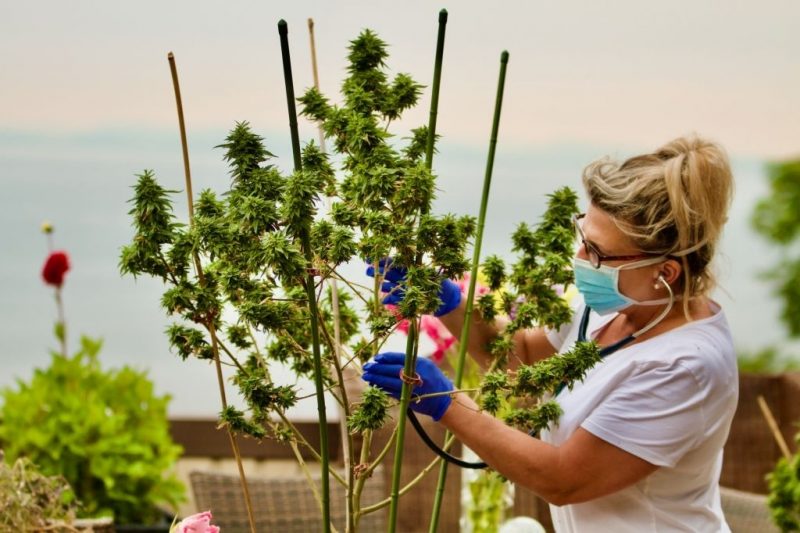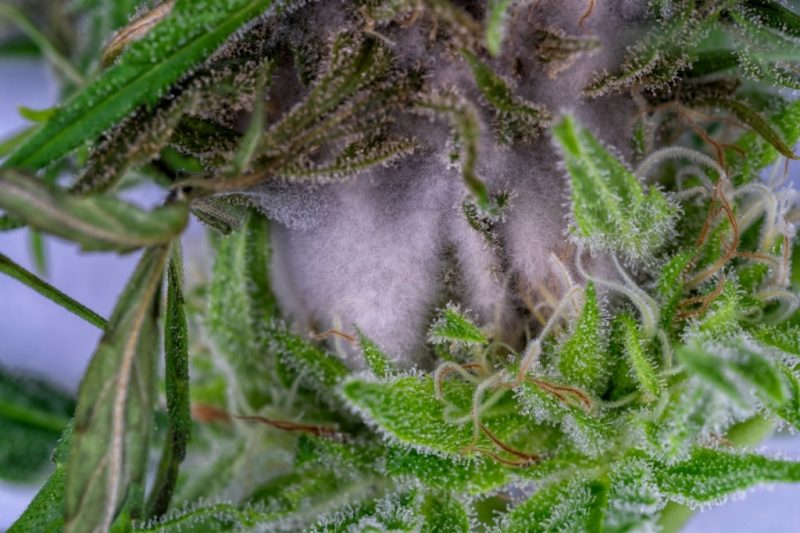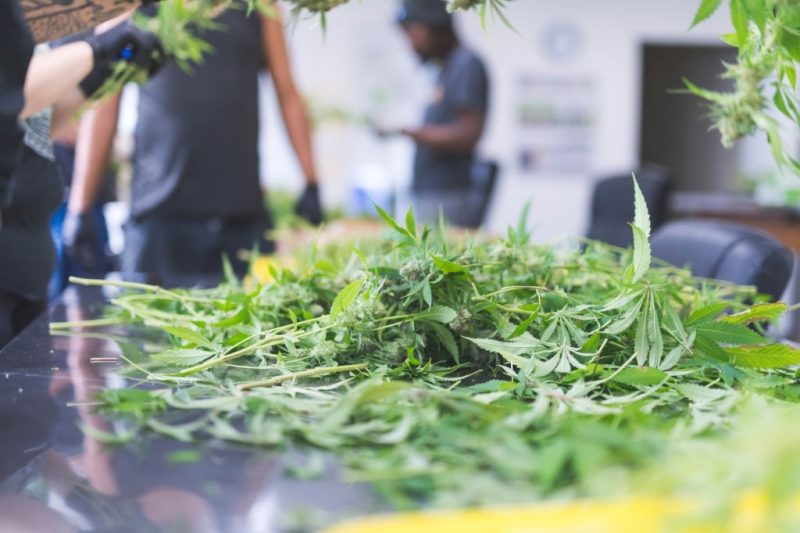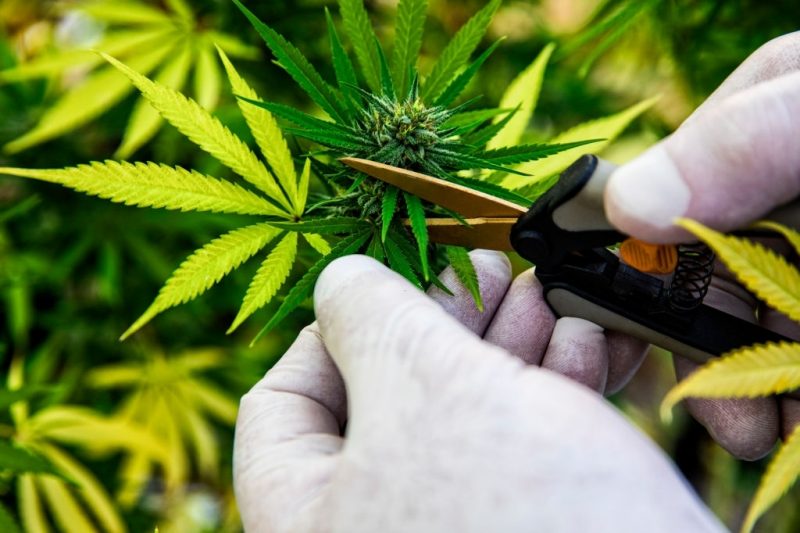🔥 Website for Sale - Contact Us
Pruning cannabis is a common plant training technique that removes parts of the plants that are not contributing to flower development. If done right, trimming shade leaves during flowering (known as defoliation) helps in numerous ways, but ultimately allows the grower to effectively control the indoor climate eco-system and communicate with the plants.
Trimming shade leaves is not a one-time process, but more of continuous maintenance that keeps plant density low and under control. Defoliation should start in the vegetation stage once the plant developed a thick fan leaf canopy and trimming continues until the late flowering stage. While trimming shade leaves during flowering can have a huge positive impact on the yield size and quality, doing it at the wrong time can send your ladies into a tailspin of demise.
After every pruning session plant growth temporarily slows down while the plant recovers from trauma which is why overdoing it can cause premature and underdeveloped flowers. Although trimming shade leaves can negatively shock the plant, there are actions you as a cultivator can take to reduce the overall trauma to your star ladies and help them to get back on the horse quicker.
Today we’ll look at how trimming shade leaves during the flowering period affects crops and how to do it right. Here is what you need to know.
Why trimming shade leaves during flowering helps with flower growth

Removing shade leaves until late flowering helps plant growth in all sorts of ways, but mainly helps with light penetration and airflow. While these two reasons are the most important for defoliating plants, humidity control, and plant growth management are side effects of pruning that carry just as much weight. Typically in nature, cannabis plants don’t need caretaking but because the aim of growers is to get the highest possible therapeutic effect (THC), pruning is essential for both indoor and outdoor cultivation.
Typically, trimming fan leaves reduces plant density by approximately 20-40% and is done every 5-7 days. While it is frowned upon to trim during the late stages of flowering, if you follow the proper procedure and best practices there is nothing to worry about. But first, let take a look at the most important reasons why pruning is needed during the flowering stage.
Here are the top four reasons why removing shade leaves is important.
1. Improve Light penetration
The most important reason why trimming fan leaves in late flowering is beneficial, is because of how plants are dependent on light energy for growth. Photogenesis is a process where plants use their leaves like solar panels to catch the light and convert it into plant growth energy.
Depending on the strain, cannabis typically grows a thick bush canopy that prevents the bottom leaves from caching any light. While there are no real plant health problems caused by fan leaves hanging in the shade of other leaves, they use precious plant grow energy while adding no value to flower production. Removing these freeloading fan leave ultimately reduces plant density which is tremendously beneficial in an indoor environment when it comes to light distribution.
It is better to have fewer fans leave that are 100% efficient than a tick bush with only 20% efficiency. Lowering plant density allows light to penetrate deep into the cannabis bush and let light reach the flower development location. This is especially important because cannabis is spot sensitive which means that focusing light on particular area results in better flower yield in that location.
Managing plant density for your ladies until the late stages of flowering are also enormously helpful when it comes to airflow.
2. Improve airflow

Proper airflow in an indoor grow room environment is critical to control high levels of humidity which can ultimately be the reason why your crop fails. Unpacking humanity and temperature topic is more than just lowering plant density but it is the best place to start.
Humidity Control
Plants breathe through tiny holes on their leaves in a process called transpiration. While everyone knows that during the daytime when there is plenty of light plants remove carbon dioxide from the atmosphere and replace it with oxygen. What is less known is that once light disappears during night time plants change this process similar to how humans depend on oxygen. During darkness when plants stop photogenesis, they absorb oxygen and replace it with corban dioxide.
While this is a pretty normal process and good for the global atmosphere, in an indoor grow environment it can push the delicate eco-system of balance and cause relative humidity to raise naturally. Carbon dioxide in a grow tent is known to be one of the biggest contributors when it comes to raising temperatures similar to global warming.
Although big fan leaves are a good sign for flower growth, they also create more carbon dioxide than smaller leaves which can exhilarate the raise of relative humidity in a small grow space.
Lower risk of disease

Trimming leaves that hang in the shade of other leave is an effective way to reduce carbon dioxide production. Besides lowering carbon dioxide, less plant density allow air to reach the entire grow space to prevent disease formation. Cannabis plants during flowing are comfortable in high humidity but without a slight wind breeze, the risk of mold formation increases dramatically.
Reducing plant density allows the plant to dance gently in the wind and prevent plant tissue from creating moisture hot spots between leaves.
Stronger stems growth
Aside from breaking up hugging plants, proper wind reach between plants tissue also promotes better stem growth. Much like athletes do resistance training in the gym, the push and pull of the wind forces the plant to grow stronger stems which can ultimately carry more flower weight.
What to avoid when trimming shade leaves during flowering
While there is much controversy around pruning during the flowering stage, doing it right can make a huge impact on flower yields. Instead of explaining how it should be done, I found that what to avoid can be more beneficial.
Avoid trimming leaves too late in the flowering process
While it is common practice to groom your ladies during the flowering stage, be cautious doing it close to harvest because it can cause all sorts of serious problems when it comes to yield size and quality.
Typically, it is good practice to stop pruning during the late flowering stage to prevent the plant from redirecting vital flower development resources to aid with trauma recovery. While flower development can still recover when this happens during early flowering, the late stages are not so forgiving. Once trichomes on the flower and sugar leave start to change color from transparent to milky while, it is best to stop any further pruning to lower stress.
Depending on the strain, trichomes change color during the last 3-6 weeks of flowing.
Avoid trimming too many fan leaves at once during flowering
Most cannabis strains are known to be pretty resilient but putting too much stress at the wrong time can make your lady become mean. Over time you are going to get a better intuition when it comes to cannabis defoliation. While it is good practice to remove about 20-40% plant density with every pruning session, during the late flowing stage this could cause serious harm.

During the final 3-6 weeks before harvest, it is best to only remove small sprouts that might start growing from open wounds from pruning. While this is common for all plants, these tiny new growths do not help the plant in any way during the late flowering stage. Because these new branches are small, removing them does not cause any significant damage to the plant and can be safely removed.





